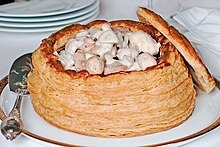Vol-au-vent
Vol-au-vent (also Bouchée à la Reine ) are tall, round pies made from puff pastry and filled with ragout . Often the dough shell alone is named that way. In Germany, the names are Queen pie or Queen pies or pasties home use. In Switzerland they are known as patties .
The invention of the vol-au-vent is often attributed to the French chef Marie-Antoine Carême (born June 8, 1784 in Paris ; † January 12, 1833 ibid) in popular literature . After that he is said to have prepared a pie with a puff pastry instead of pie dough; when his assistant looked at her, he exclaimed: Maître, il vole au vent! (“Master, it flies in the air!”), Because a tower-like shape was created from the flat dough. However, it has been proven to be a legend. The term Vol-au-vent first appeared in France in 1739 in the book Le Dons de Comus by François Marin , long before Carême was born.
For the production of the pastry sheets, several round, roughly palm-sized slices are cut out of sheets of puff pastry, one set aside and the inside of the others cut out so that rings are formed. Several of these rings are glued to a disc with battered egg whites. When baked, they open into a cylindrical cup shape, and a smaller disc later serves as a lid.
The pastry covers are then filled with a ragout (often ragout fin ) and, depending on the recipe, baked again in the oven. At the end the dough lid is put on and the whole thing is served hot. The classic French vol-au-vent of the 19th century were filled à la financière with a garnish of mushrooms, truffles and cockscomb and à la marinière with seafood .
Individual evidence
- ↑ Patty recipe
- ^ A b Claudine Brécourt-Villars, Mots de table, mots de bouche , Paris 1997, p. 386
